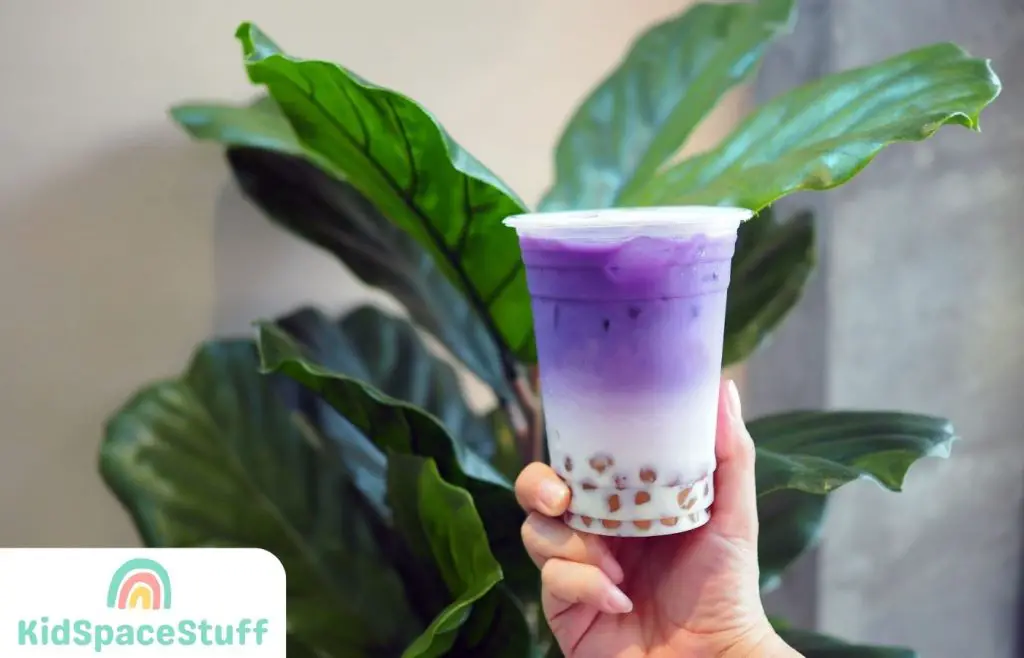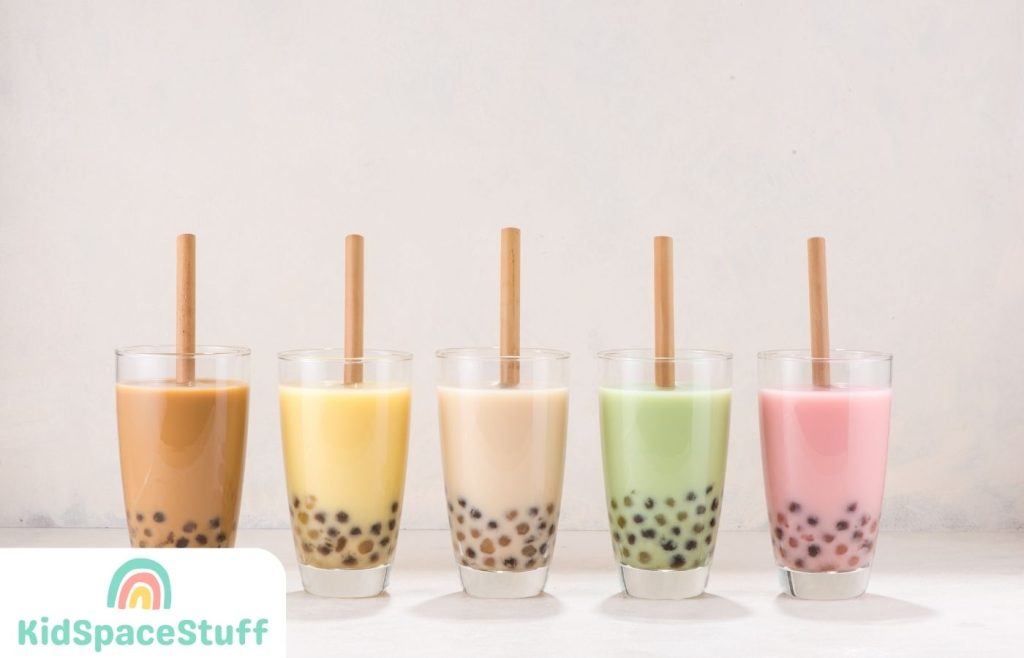Boba, also known as bubble tea or pearl milk tea, has become a worldwide sensation, captivating taste buds with its unique blend of flavors and textures.
But, as a parent, you may wonder: Is boba suitable for kids?
In this article, I’ll dive into the world of boba – examining its ingredients, nutritional value, and whether it’s a beverage that kids can safely enjoy. Strap in for an exploration of this trendy drink and what it means for your child’s diet!
Can Kids Drink Boba?

We know that kids love sweet treats, and bubble tea, also known as boba, pearl milk tea, or bubble milk tea, is no exception. But as parents, we might wonder if it’s safe for our children to enjoy this popular beverage.
Boba refers to the chewy, black tapioca pearls that are typically found at the bottom of a bubble tea drink. These pearls are mainly made of cassava starch and, in some cases, may contain small amounts of caffeine due to their tea base. However, the caffeine content in boba tea is generally low, and it shouldn’t cause any significant issues for kids aged 6 and over who can handle new textures and have experience with small toppings in their drinks.
However, there is a concern about the safety of young children consuming boba due to the risk of choking on the tapioca pearls. So, it’s crucial to be mindful of that aspect, especially when introducing bubble tea to younger kids or those who might be less experienced with handling the chewy texture.
Apart from that, keep in mind that some bubble tea drinks can be very high in sugar, especially if you choose sweetened syrups, flavored powders, or fruit jellies as additional toppings. As with any sugary treats, moderation is key. We don’t want to encourage excessive sugar intake, which can lead to dental issues and other health concerns in the long run.
Is Boba Safe for Kids?
Ingredients in Boba Tea
Boba tea, also known as bubble tea, is a popular Taiwanese drink that contains a tea base, milk or fruit flavoring, sweeteners, and tapioca pearls. The tapioca pearls are made from cassava roots, water, and sugar.
While most of the ingredients are generally safe for kids, it’s important to consider the caffeine content in the tea, as well as other factors that may affect a child’s health.
High caffeine drinks like Gfuel and Celsius aren’t suitable for kids, but drinks with less caffeine like decaf coffee can be perfectly fine for kids.
Chewing and Choking Hazards
One concern about serving boba tea to kids is the potential choking hazard posed by the tapioca pearls. These small, chewy pearls may be difficult for younger children to manage, especially if they’re under six years old and not yet adept at handling new textures. To minimize safety risks, it’s best to introduce boba tea to kids aged six and over who can comfortably chew and swallow the pearls without issue.
Health Concerns for Kids
Boba tea does contain some caffeine, which can affect children’s sleep patterns, behavior, and overall health. It’s essential to monitor the caffeine intake of kids to ensure it doesn’t lead to any adverse side effects. Additionally, many boba teas contain high amounts of added sugar, which can contribute to tooth decay, obesity, and other health problems if consumed in large quantities. Parents should choose boba tea options with lower sugar content or consider making their own healthier versions at home.
Nutritional Considerations
Though boba tea may seem like a tasty treat, it’s worth noting that it offers very limited nutritional benefits. Boba pearls themselves only provide calories and carbohydrates, without much else in the way of vitamins or minerals. As such, it’s important to treat boba tea as a treat rather than a staple in a child’s diet.
In summary, while boba tea can be safe for kids to consume, it’s essential to consider the possible choking hazards, caffeine content, added sugars, and limited nutritional value. By being mindful of these factors and ensuring moderation, parents can feel more at ease allowing their kids to enjoy this trendy beverage.
Is Boba Healthy?

Bubble tea, also known as boba tea, is a popular Taiwanese drink that has gained popularity worldwide. We’ve been asked many times whether it’s healthy for kids to drink. First, let’s talk about the ingredients in boba tea. Boba is made from tapioca pearls, which are derived from the starch of the cassava root. These pearls are then mixed with tea, milk, and sugar to create the final drink.
From a nutritional standpoint, boba tea contains calories, carbohydrates, and sugar. According to the USDA, 8 ounces of boba tea has approximately 120 calories, 28 grams of carbohydrates, and 28 grams of sugar. This might raise concerns, especially for kids, as a high sugar intake can lead to obesity and other health issues.
Regarding the caffeine content, boba tea does contain some caffeine, as it is made using tea leaves. The caffeine content will vary depending on the type of tea used. But, if your kid is already consuming regular tea, boba should be fine in moderation.
One of the downsides of boba tea is the added sugar that it typically contains. The sugar content can be very high, especially if you’re buying it from a cafe or store, as they tend to add more sugar for taste. If you want to give your child a healthier version of boba tea, you can try making it at home with less sugar and choose healthier milk options like almond or soy milk.
To sum it up, while boba tea might not be the healthiest option for kids to drink routinely, it can still be a fun and delicious treat once in a while. Just make sure to keep track of the sugar and caffeine content and try to make healthier choices when possible.
Alternative Boba Options for Kids
When you’re at a boba shop, options may seem overwhelming. Fear not! We’ve got your back with some kid-friendly alternatives so that your little ones can enjoy this delightful beverage too.
First things first, let’s remember that the sweetness level in boba drinks can be adjusted. We suggest opting for a lower sugar level for kids, since some boba drinks can be quite high in sugar. You can also consider asking for honey as a natural sweetener, which is both delicious and a healthier alternative.
We absolutely love passion fruit in our boba drinks. It adds a flavor that kids will enjoy. Try adding some passion fruit to a fruit tea, which has a lighter taste compared to milk teas. Fruit teas are refreshing, packed with fruity flavors, and can be customized with various fruit combinations.
Speaking of fruit, don’t be afraid to get creative with flavor combinations for kids. Some popular kid-friendly flavors include strawberry, mango, and peach. You can mix and match these flavors to find the perfect blend your child will enjoy.
If you’re looking for a simple yet tasty option, a classic fruit tea with a twist might do the trick. Take a basic fruit tea and add some chewy tapioca pearls or fruity popping boba as toppings. These can be a fun addition for kids, making the experience exciting and interactive.
In conclusion, be open to exploring new flavor combinations and adjust the sweetness level as needed to create a delicious and kid-friendly boba drink. With some creativity and mindfulness, you can treat your kids to a delightful and healthier boba experience.
Frequently Asked Questions
Is bubble tea suitable for young children?
Bubble tea can be a fun and enjoyable treat for children, but it’s essential to keep a few things in mind. While the tea itself is generally safe, the boba or tapioca pearls can pose a choking hazard, especially for younger kids. We recommend supervising your child while they enjoy their bubble tea and ensuring they chew the boba thoroughly before swallowing.
What age is it okay for kids to have bubble tea?
There is no specific age cutoff for introducing bubble tea to your child. However, it’s important to consider the possible choking hazard associated with the boba pearls. We suggest waiting until the child is at least 4 years old since, by this age, they’re typically able to chew solid food properly. Again, always supervise your child during consumption, no matter their age.
Are there any risks of kids consuming boba?
Aside from the possible choking hazard mentioned earlier, some concerns may arise regarding sugar content and caffeine levels in bubble tea. We advise parents to choose bubble tea options that are lower in sugar and caffeine to minimize these concerns. It’s also a good idea to consume bubble tea as an occasional treat rather than a regular part of your child’s diet.
What boba flavors are kid-friendly?
Many bubble tea shops offer a wide range of flavors, including fruity ones like strawberry, mango, and peach, which are often a hit with kids. Some shops also have non-caffeinated options such as yogurt or milk-based drinks that may be more suitable for younger children. Don’t be afraid to ask your local boba shop for recommendations to help find a flavor your child will enjoy.
Are there any alternatives to boba for children?
If you’re not comfortable with your child consuming boba due to potential risks, there are alternatives you can explore. Some bubble tea shops offer fruit jelly, popping boba, or fruit bits as toppings instead of traditional tapioca pearls. These options can be a great way to introduce your child to the fun and novelty of bubble tea, without the potential choking hazard of regular boba pearls.
Final Thoughts
To wrap up, while the occasional boba drink can be a fun treat for kids, its high sugar content and potential choking hazard mean it’s not something to be consumed frequently or by very young children. As with any food or drink, moderation and caution are key.
Always supervise young children when they’re trying boba for the first time and consider asking for less or no sugar when ordering. Ultimately, responsible boba consumption can be part of the journey in teaching your kids about balanced eating and drinking habits.
KidSpaceStuff is a site dedicated to helping parents find the best interior design, activities, and inspiration for their kids.